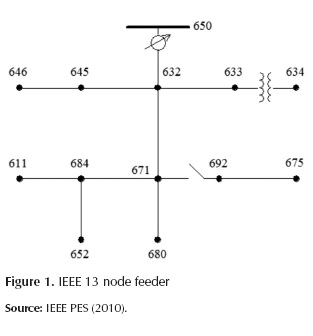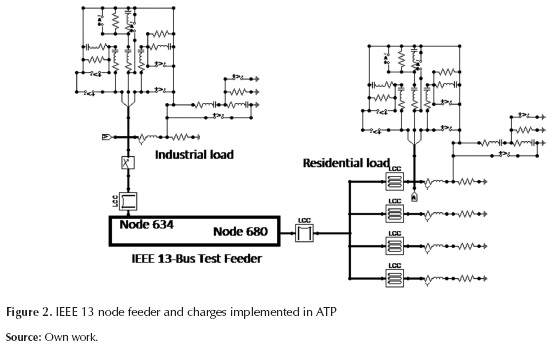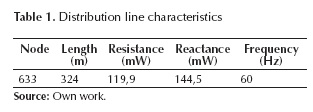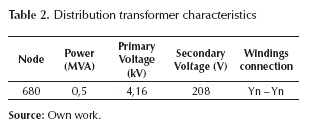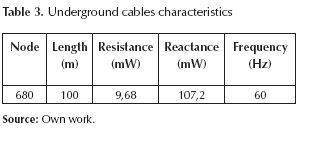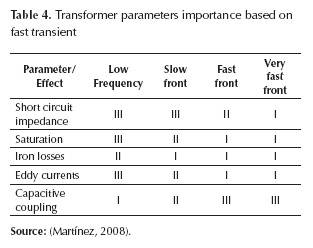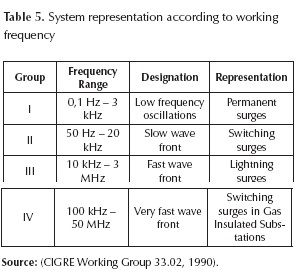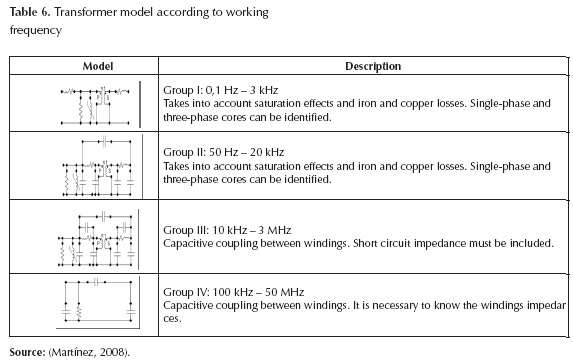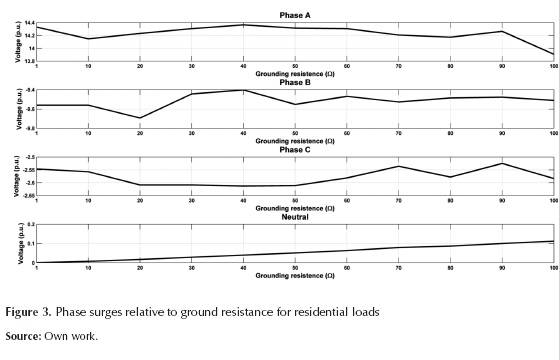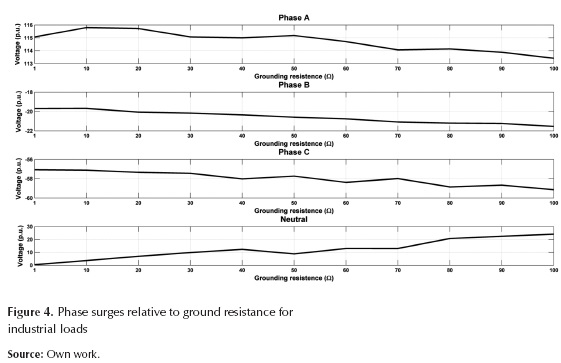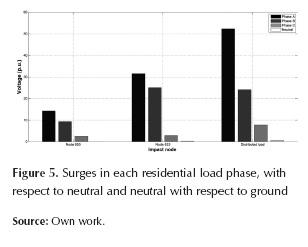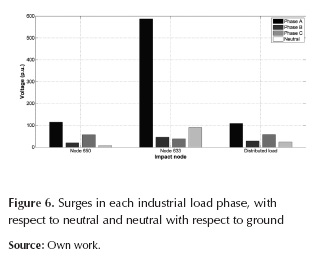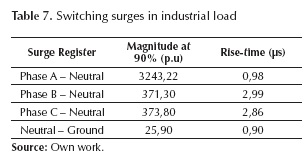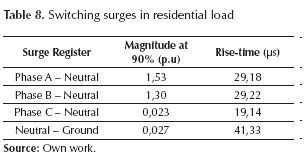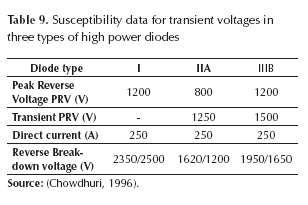Serviços Personalizados
Journal
Artigo
Indicadores
-
 Citado por SciELO
Citado por SciELO -
 Acessos
Acessos
Links relacionados
-
 Citado por Google
Citado por Google -
 Similares em
SciELO
Similares em
SciELO -
 Similares em Google
Similares em Google
Compartilhar
Tecnura
versão impressa ISSN 0123-921X
Tecnura vol.18 no.spe Bogotá dez. 2014
https://doi.org/10.14483/udistrital.jour.tecnura.2014.DSE1.a03
DOI: http://doi.org/10.14483/udistrital.jour.tecnura.2014.DSE1.a03
Transient surges analysis in low voltage networks
Análisis de transitorios de sobretensión en redes de baja tensión
Andrés Alfonso Rodríguez*, Luis Eduardo Perdomo Orjuela**, Francisco Santamaría Piedrahíta***, Carlos Antonio Gómez Vargas****
* Electrical Engineer, Electromagnetic Compatibility and Interference Research Group, Universidad Distrital Francisco José de Caldas. Bogotá, Colombia. aalfonsor@correo.udistrital.edu.co
** Electrical Engineer, Electromagnetic Compatibility and Interference Research Group, Universidad Distrital Francisco José de Caldas. Bogotá, Colombia. leperdomoo@correo.udistrital.edu.co
*** Electrical Engineer, MSc., PhD., Associated Professor at the Faculty of Engineering - Universidad Distrital Francisco José de Caldas, Bogotá, Colombia. fsantamariap@udistrital.edu.co
**** Electrical Engineer, MSc (c). Professor at the Faculty of Engineering - Universidad Central, Bogotá, Colombia. cgomezv1@ucentral.edu.co
Fecha de recepción: June 10th, 2014 Fecha de aceptación: November 4th, 2014
Citation / Para citar este artículo: Rodríguez, A. A., Perdomo Orjuela, L. E., Santamaría Piedrahíta, F., & Gómez Vargas, C. A. (2014). Transient surges analysis in low voltage networks. Revista Tecnura, 18 (Edición especial doctorado), 41-50. doi: 10.14483/udistrital.jour.tecnura.2014.DSE1.a03
Abstract
Sensitivity analysis of a power system against overvoltage was performed. The analysis took into account the origin of the overvoltage, the grounding resistance magnitude and overvoltage injection point. The IEEE 13 bus test feeder system was implemented in EMTP-ATP and lightning and switching overvoltages were applied. Three cases were evaluated: the first one, applying lightning overvoltage and varying the grounding resistance magnitude; the second, applying lightning overvoltage in different points of the system with a fixed grounding resistance magnitude; and finally, applying switching overvoltage and varying the grounding resistance magnitude.
Keywords: EMTP-ATP, Ground Resistance, Power Quality, Transformer Model, Transient Overvoltage.
Resumen
Se realizó un análisis de sensibilidad en un sistema de potencia frente a sobretensiones. El análisis tuvo en cuenta el origen de la sobretensión, la magnitud de resistencia de puesta a tierra y el punto de inyección de sobretensión. El sistema IEEE 13 nodos se implementó en EMTP ATP y se introdujeron sobretensiones tipo rayo y maniobra. Se evaluaron tres casos, el primero, aplicando una sobretensión tipo rayo y variando la magnitud de resistencia de puesta a tierra; el segundo, aplicando sobretensiones tipo rayo en diferentes puntos del sistema con una magnitud de resistencia de puesta tierra fija y, por último, aplicando sobretensiones tipo maniobra variando la magnitud de resistencia de puesta a tierra.
Palabras clave: EMTP-ATP, resistencia de tierra, calidad de potencia, modelo del transformador, sobretensiones transitorias.
Introduction
Low voltage feeders may be affected by surges, giving rise to phenomena such as short interruptions and voltage sags (Cooray, 2003). These surges are generated by direct lightning strikes in low voltage feeders, induction by indirect discharges (intra-cloud, cloud-to-cloud, cloud-to-air or cloud-to-ground) (Pham, Pham & Tran, 2010), and surges of slow, fast and very fast front, transferred from medium voltage networks to low voltage networks (Piantini, 2010; Varju & Ladanty, 2007; Borghetti et al., 2006; Watson & Arrillaga, 2007).
The probability of direct lightning strikes in low voltage networks is very low due to the shielding action of medium voltage networks, trees and nearby structures. However, the length of rural and semi-urban low voltage feeders may exceed 1000 m, increasing the lightning strike probability (Piantini, 2010). Surges in low voltage networks transferred from medium voltage feeders through distribution transformers are mainly caused by direct and indirect lightning strikes (Piantini, 2010; Bachega & Martínez, 2004). Therefore, in the system modeling it is necessary to consider the transformer behavior to these transient signals; however, the transformer steady state model is not useful for a lightning overvoltage frequency range (Das, 2010), (Papadias, Hatziargyriou, & Prousalidis, 1993). In this sense, implemented models of surge transfer from medium voltage feeders to low voltage feeders include a capacitive network of the transformer (Scott & Liu, 1992; Costa & López, 2007; Justo de Araújo, Cleber da Silva & Kurokawa, 2013).
This work is part of the first phase of the project called "prototype for recording transient surges in less than 1 kV feeders". The project main goals are: development of a surge recorder prototype applying electromagnetic compatibility standards, remote information transmission from prototype to desktop software, and development of a mobile application for downloading the recorded information on site and display the database information.
This paper shows typical surge parameters of low voltage systems, as peak voltage and rise time, in order to identify the behavior of surges in systems lower than 1 kV. This information is also used for designing the prototype signal conditioning stage. Simulations for IEEE 13 node test feeder (IEEE PES Distribution System Analysis Subcommittee's Distribution Test Feeder Working Group, 2000-2010), were done using the Alternative Transient Program (ATP) (Scott & Liu, 1992) for two conditions. In the first case, normalized waveform voltages 1,2/50 ms were applied in many system points. In the second case, surges caused by disconnection of an industrial load were evaluated. Furthermore, the grounding system effect on surge value was evaluated in all cases.
SYSTEM DESCRIPTION
IEEE 13 node system (IEEE PES Distribution System Analysis Subcommittee's Distribution Test Feeder Working Group, 2000-2010) was used as reference for characterizing low voltage feeder surges. The topology of the test system is shown in Figure 1.
The ATP implemented system is shown in figure 2. Nodes 650 and 633 were used for simulating the lightning impact, and the distributed loads were located in nodes 632 and 671. Additionally, a Heidler source of 4 kV peek voltage was implemented to represent a standard lightning surge 1,2/50 µs. (Martínez, 2008; Morched, Matí & Ottevangers, 1993; Costa & López, 2007). Opening of one phase of an industrial load has a highly inductive characteristic and causes system high power consumption. Therefore, the opening was used for slow front surge characterization. The system was implemented in order to evaluate the sensitivity to direct impact and switching surges. IEEE 13 node feeder was modified to analyze overvoltages in low voltage for ground resistance variation.
Industrial load
An inductive load of high power consumption (0,25 MVA and power factor of 0,85) was included in the distribution system. This load is connected to node 634 through a distribution line whose characteristics are given in Table 1.
Residential load
Four residential loads, each one of 7 kVA and power factor 0,85 lagging were added. Connection of IEEE 13 node system to residential loads was performed through a distribution transformer located on node 680. Distribution overhead and underground cables were implemented to represent the supply connection of loads (Martínez, 2010), (CIGRE Working group 33.02, 1990). Table 2 and Table 3 show the transformer and cables characteristics.
Transformer model
Right modeling of low voltage feeder components influences the analysis of surges (Bachega & Martínez, 2004). The transformer deserves particular attention because it transfers surges present in medium voltage networks to low voltage feeders (Antunes Tavares & Melo e Silva, 2014), (Martínez, 2010). Searching a suitable high frequency model transformer is considered a complex task because of the physical phenomena occurring in this device. Physical Phenomena such as (CIGRE Working group 33.02, 1990), (IEEE standars association, 2011):
- When the transformer is turned on, winding capacitances charging process starts and current flow begins in the dielectric structure.
- Losses in the transformer core are negligible because it has a linear behavior. Magnetic flux penetration into the core is not presented until 1 μs elapsed.
- After 1 μs, the flux begins to penetrate into the core, the main current path are the capacitances.
- From 1 μs to 10 μs, the transformer core saturates.
- Completed 10 μs, the inductance coil has a non-linear behavior and magnetic flux will be fully penetrated into the core. In this stage, capacitive couplings remain its importance.
- After 10 μs, the behavior of transformer is considered stable. Losses come from cables, core, dielectric and housing. Skin effect is considered in this section.
Transformer parameters importance depends on the analyzed process. Table 4 shows the transformer parameters influence in a power system transient analysis. The classification proposed in Martínez (2008) is: I unimportant, II important, and III very important.
CIGRE Working Group 33-02 has elaborated a document (CIGRE Working group 33.02, 1990) for specifying the power system elements representation according to the frequency ranges in which the system behavior will be evaluated. Table 5 shows this information.
Table 5 shows the transformer modeling information respect to frequency range (Martínez, 2008).
Methodology
This section describes the scenarios proposed to evaluate the system sensitivity against surges caused by direct lightning strike impacts and system switching. Direct lightning strike has a 1,2/50 μs standard waveform with an amplitude of 4 kV, and 90% of occurrence probability (Borghetti, Napolitano, Nucci, Paolone, & Morched, 2006).
Grounding resistance
Grounding impedance has been included in order to evaluate its impact on surge in the low voltage system; it allows also to record surges in the neutral line. For simulation, a resistive model of grounding impedance was implemented, following electromagnetic compatibility design criteria, which allow neglect inductive coupling. High and medium voltage grounding resistance values are 1 and 10 Ω respectively (Ministerio de Minas y Energía, República de Colombia, 2008). Low voltage resistances are in the range of 1 to 100 Ω.
Case 1: direct lightning strike and low voltage grounding resistance variation: A lightning surge wave was injected in phase A of node 650. Grounding resistance was varied between 1 and 100 Ω, with 10 Ω steps. For residential and industrial loads, surges were measured in phases and neutral of the system.
Case 2: fixed low voltage grounding resistance and variable lightning strike point: A 25 Ω ground resistance was fixed (Ministerio de Minas y Energía, República de Colombia, 2008). A lightning surge wave was injected in phase A of nodes 650, 633 and in the distributed line in nodes 632 and 671. Surges were measured in phases and neutral of the system for residential and industrial loads.
Case 3: Switching phase A of industrial load. Low voltage grounding resistance kept constant and simultaneous measurement at different points of the system: The magnitude of low voltage ground resistance is 25 Ω. Phase A of industrial load was opened, which caused a switching surge. Surges were measured in phases and neutral of the system for residential and industrial loads.
Results
Results of ATP simulations for the described study cases are presented below. The results are in p.u., line voltages base values are 480 V and 208 V for industrial and residential loads, respectively.
Case 1: direct lightning strike and low voltage grounding resistance variation
Figure 3 and figure 4 show the magnitude of the surge registered respectively in residential and industrial load, in all phases and neutral. Phase voltage is measured with respect to neutral and neutral with respect to ground. Phase A results in Figure 3 suggest the need of a protection device for connected electronics and electric machines to avoid the progressive damage of components (Chowdhuri, 1996; Indulkar, Thomas & Bijwe, 1992). Figure 4 shows that for a grounding resistance larger than 15 Ω, an electronic device or an electric machine would be subject to voltages higher than 4 kV. These levels cause electromagnetic susceptibility problems (IEEE Std 1159 Recommended practice for monitoring electric and power quality, 2009), (IEEE Std 446 Recommended practice for emergency and standby power systems for industrial and commercial applications, 1995), (Herrera, Perez, & Torres, 2003), (Escamilla, Gomez, & Tejada, 2009), (Gómez, 2013).
Case 2: fixed low voltage grounding resistance and variable lightning strike point
Figure 5 and Figure 6 show the surges at 90% of the peak value, recorded in residential load phases and industrial load phases, respectively, with respect to neutral and neutral with respect to ground, for different lightning strike injection points.
Surges produced by disturbances in several points of the system, and recorded in the residential load, confirm that for grounding resistance lower than 25 Ω, the grounding potential level can be tolerated by electronic devices (Ministerio de Minas y Energía, República de Colombia, 2008).
Surge recorded in phase A when a lightning transient occurs in node 633 reaches levels up to four times the ones recorded in other nodes of industrial load. This is due to the low impedance between the impact point and the register point, together with the non-transposed lines, as shown in figure 6.
Case 3: Opening phase A of industrial load. Low voltage grounding resistance kept constant and simultaneous measurement at different points of the system
Table 7 and Table 8 show the magnitudes at 90% of peak value and rise time of surge between each phase and neutral measured in the residential and industrial load, when a surge is generated by phase A opening of industrial load.
Slow front surges produced by switching the phase A, depends on time when the switch opens and the arc dynamic behavior at the same time (Indulkar, Thomas, & Bijwe, 1992). According to table 7, in the industrial load the surge magnitude in phase A is ten times higher than the recorded in phases B and C. This is due to the inductive load rises the voltage level in response to abrupt current changes. Furthermore, induced surges in the other circuit phases are exponentially attenuated with respect to the network characteristic impedance. Table 7 and table 8 show the surge values in phase B (371,3 p.u. and 1,3 p.u., respectively).
Colombian standard for internal surge protection systems (NTC 4552 Protección contra rayos, 2004), shows the impulse voltage values that devices must withstand according to their operation levels. For Colombian power system at residential low voltage, the impulse values would be equal to or less than 2,5 kV. This value was exceeded in the first two simulation cases; therefore, surge protection devices are required. Proper design of protection devices as diodes, thyristors, surge protectors, etc., must follow appropriate selection criteria. For protection of electronic devices at residential load, three diodes with different characteristics were selected. Type I is an avalanche diode, type IIA and IIB are non-avalanche diodes, as shown in table 9 (Chowdhuri, 1996).
Conclusions
Surge magnitude depends on distance to impact point, regardless if load is industrial or residential, at shorter distances, greater magnitudes.
Design values of grounding resistance for residential loads must be less than 25 Ω, in agreement with Colombian regulation standards. Surge registered in neutral line presents a linear behavior with respect to grounding resistance value. This linear behavior enables a proportionality constant to predict the surge level at neutral. However, in the phases the behavior is not predictable, making impossible to use a proportionality constant.
Signals recorded from ATP simulations show the importance of measuring and characterizing the overvoltages in low voltage systems, in order to determine the origin of these surges and possible strategies to reduce their negative effects. According to the registered magnitudes, it is necessary to calculate and implement protective devices designed to protect the life of sensitive equipment installed in the low voltage system.
References
Antunes Tavares, K. & Melo e Silva, K. (2014). Evaluation of power transformer differencial protection using the ATP software. IEEE Latin America Transactions, 12(2), 160-168. [ Links ]
Bachega, R. & Martínez, M. (2004). Transformer Modeling for Transferred Voltages. Transmission and Distribution Conference and Exposition: Latin America, 2004 IEEE/PES. [ Links ]
Borghetti, A. et al. (2009). Lightning-Induced Overvoltages Transferred Through Distribution Power Transformers. Power Delivery, IEEE Transactions on, 24(1), 360-372. [ Links ]
Borghetti, A. et al.(2006). Lightning-Induced Overvoltages Transferred from Medium-Voltage to Low-Voltage Networks. Power Tech. St. Petersburg. [ Links ]
Chowdhuri, P. (1996). Electromagnetic transients in power systems. New York: John Wiley & Sons INC. [ Links ]
CIGRE Working group 33.02. (1990). Guidelines for representation of network elements when calculating transients. Technical brochure 39. [ Links ]
Cooray, V. (2003). The lightning flash. London: The institution of engineering and technology. [ Links ]
Costa Quintana, J. & López Aguilar, F. (2007). Interacción electromagnética teoría clásica. Barcelona: Reveté, S.A. [ Links ]
Das, J. (2010). Transients in electrical systems. New York: McGraw-Hill. [ Links ]
De Contí, A. & Visacro, S. (2005). Evaluation of lightning surges transferred from medium voltage to low-voltage networks. Generation, Transmission and Distribution, IEE Proceedings, 152(3), 351-356. [ Links ]
Escamilla, J., Gomez, P. & Tejada, C. (2009). Single-Phase Transformer Modeling for Analyzing Transient Overvoltages Distribution and Transference. Latin America Transactions, IEEE, 7(5), 545-551. [ Links ]
Gómez, P. (2013). Performance evaluation of time domain transmission line models for a statistical study of switching overvoltages. IEEE Latin America Transactions, 11(4), 1036-1046. [ Links ]
Herrera, J., Perez, E. & Torres, H. (2003). Statistical evaluation of transferred voltages through transformers due to lightning induced overvoltages. Power Tech Conference Proceedings, 2003 IEEE Bologna. Bologna. [ Links ]
IEEE PES Distribution System Analysis Subcommittee's Distribution Test Feeder Working Group. (2000-2010). IEEE Power and Energy Society. (IEEE) Acesso em 02 de 11 de 2013, disponível em http://ewh.ieee.org/soc/pes/dsacom/testfeeders/index.html. [ Links ]
IEEE standards association. (2011). IEEE guide for improving the lightning performance of electric power ovehead distribution lines. New York: IEEE Power & energy society. [ Links ]
IEEE Std 1159 Recommended practice for monitoring electric and power quality. (2009). New York: The Institue of Electrical and Electronics Engineers, Inc. [ Links ]
IEEE Std 446 Recommended practice for emergency and standby power systems for industrial and commercial applications. (1995). New York: The Institute of Electrical and Electronics Engineers, Inc. [ Links ]
Indulkar, C., Thomas, M. & Bijwe, P. (1992). Switching overvoltages in a three-phase transformer. Circuits and Systems, 1992., Proceedings of the 35th Midwest Symposium on. Washington, DC. [ Links ]
Justo de Araújo, A., Cleber da Silva, R. & Kurokawa, S. (2013). Representation of transmission lines: a comparison between th model distributed parameters and lumped parameters. IEEE Latin America Transactions, 11(4), 1047-1052. [ Links ]
Liu, T. & Scott, W. (1994). Electro magnetic transients program (EMTP) Theory book. Portland: Bonneville power administration. [ Links ]
Martínez, J. (2008). Coordinación de aislamiento en redes eléctricas de alta tensión. Madrid: McGraw-Hill. [ Links ]
Martínez, J. (2010). Power system transients parameter determination. CRC Press. [ Links ]
Ministerio de Minas y Energía, República de Colombia. (2008). Reglamento técnico de instalaciones eléctricas. RETIE. Bogotá, Colombia: Ministerio de Minas y Energía, República de Colombia. [ Links ]
Morched, A., Martí, L. & Ottevangers, J. (1993). A high frequency transformer model for the EMTP. IEEE Transactions on power delivery, 8(3), 1615-1626. [ Links ]
NTC 4552 Protección contra rayos. (2004). Bogotá, DC: ICONTEC. [ Links ]
Papadias, B., Hatziargyriou, N. & Prousalidis, J. (1993). Transformer Modeling for Switching Overvoltages. Athens Power Tech, 1993. APT 93. Proceedings. Joint International Power Conference. Athens. [ Links ]
Pham, T., Pham, N. & Tran, V. (2010). EMTP Simulation of Induced Overvoltage in Low Voltage System. Electrical Insulation (ISEI), Conference Record of the 2010 IEEE International Symposium on, 1-4. San Diego, CA. [ Links ]
Piantini, A. (2010). Lightning protection of low-voltage networks. In V. Cooray, Lightning protection, 553-611. London: The Institution of Engineering and Technology. [ Links ]
Piantini, A. (2010). Lightning protection of low-voltage networks. Lightning protection, 553-634. London: The Institution of Engineering and Technology. [ Links ]
Scott, W. & Liu, T. (1992). Alternative transients program ATP Rule Book. Portland: Canadian/American EMTP User Group. [ Links ]
Varju, G. & Ladanyi, J. (2007). Transient Power Frequency Overvoltages Transferred to Low Voltage Networks From the EPR of HV and MV Transformer Stations. Electromagnetic Compatibility and Electromagnetic Ecology, 2007 7th International Symposium on. Saint-Petersburg. [ Links ]
Watson, N. & Arrillaga, J. (2007). Power systems electromagnetic transients simulation. London: Institution of Engineering and Technology. [ Links ]
FUNDING
This work was supported by Universidad Distrital Francisco José de Caldas.













